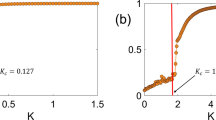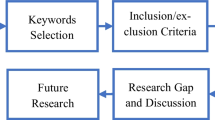Abstract
Given a large number (the “flock”) of moving physical objects, we investigate physically reasonable mechanisms of influencing their orbits in such a way that they move along a prescribed course and in a prescribed and fixed configuration (or “in formation”). Each agent is programmed to see the position and velocity of a certain number of others. This flow of information from one agent to another defines a fixed directed (loopless) graph in which the agents are represented by the vertices. This graph is called the communication graph. To be able to fly in formation, an agent tries to match the mean position and velocity of his neighbors (his direct antecedents on the communication graph) to his own. This operation defines a (directed) Laplacian on the communication graph. A linear feedback is used to ensure stability of the coherent flight patterns. We analyze in detail how the connectedness of the communication graph affects the coherence of the stable flight patterns and give a characterization of these stable flight patterns. We do the same if in addition the flight of the flock is guided by one or more leaders. Finally we use this theory to develop some applications. Examples of these are: flight guided by external controls, flocks of flocks, and some results about flocks whose formation is always oriented along the line of flight (such as geese).
Similar content being viewed by others
References
Arnold V.I. Ordinary Differential Equations (MIT Press, 1973)
R. Brualdi and H. Ryser, Combinatorial Matrix Theory, Encyclopedia of Mathematics and Its Applications (Cambridge University Press, 1991)
J. Caughman and J. J. P. Veerman, Kernels of Directed Graph Laplacians (Portland State University, 2005, submitted for Publication). Note added in Proof: A different formulation of these results has very recently appeared in: R. Agaev, P Cheobotarev, On the spectrum of NonSymmetric Laplacian Matrices, Lin. Alg. & Appl. 399: 157–168 (2005)
J. A. Fax, Optimal and Cooperative Control of Vehicle Formations, Ph. D. Thesis, (California Institute of Technology, 2001)
J.A. Fax R.M. Murray (2003) ArticleTitleInformation flow and cooperative control of vehicle formations IEEE Trans. Automatic Control 49 IssueID9 1465–1476 Occurrence Handle2005e:90013
B. Francis, personal communication
C. Godsil and G. Royle, Algebraic Graph Theory (Springer, 2001)
D. Guedes de Figueiredo, Análise de Fourier e Equações Diferenciais Parciais, IMPA-CNPQ (Rio de Janeiro, 1977)
M. W. Hirsch and S. Smale, Differential Equations, Dynamical Systems, Linear Algebra (Academic Press, 1974)
A. Jadbabaie J. Lin A.S. Morse (2003) ArticleTitleCoordination of groups of mobile autonomous agents using nearest neighbor rules IEEE Trans. Automatic Control 48 IssueID6 998–1001 Occurrence Handle10.1109/TAC.2003.812781 Occurrence Handle2004m:82095
G. Lafferriere, J. Caughman and A. Williams, Graph theoretic methods in the stability of vehicle formations, Proc. 2004 Am Control Conf. 3724–3729 (2004)
G. Lafferriere A. Williams J. Caughman J.J.P. Veerman (2005) ArticleTitleDecentralized control of vehicle formations System & Control Lett. 54 899–910 Occurrence Handle2006b:93011
J. Lawton R. Beard B. Young (2003) ArticleTitleA decentralized approach to formation maneuvers IEEE Trans. Robotics and Automation 19 IssueID6 933–941 Occurrence Handle10.1109/TRA.2003.819598
J. Milnor, Dynamics: Introductory Lecture Notes (Stony Brook Preprint, 2001)
Moreau L. Leaderless coordination via bidirectional and unidirectional time- dependent communication. Proc. IEEE Conf Decision and Control 3070–3075 (2003)
A. Okubo (1986) ArticleTitleDynamical aspects of animal grouping: swarms, schools, flocks, and herds Adv. Biophys. 22 1–94
Olfati-Saber R., Murray R. Agreement problems in networks with directed graphs and switching topology. Proc IEEE Conference on Decision and Control 4126–4132 (2003)
R. Olfati-Saber and R. Murray, Consensus protocols for networks of dynamic agents in Proc. IEEE Conference on Decision and Control 4126–4132 (2003)
J. K. Parrish, personal communication
J.K. Parrish S.V. Viscido D. Grünbaum (2002) ArticleTitleSelf-organized fish schools: an examination of emergent properties Biol. Bull. 202 296–305
Ren W., Beard R. (2004). Consensus of information under dynamically changing interaction topologies. Proc. Am. Control Conf. 4939–4944
W. Ren R. Beard (2004) ArticleTitleA decentralized scheme for spacecraft formation flying via the virtual structure approach, AIAA J. of Guidance Control and Dynamics 27 IssueID1 73–82
W. Ren and R. Beard, Consensus seeking of multi-agent systems under dynamically changing interaction topologies, IEEE Trans. Autom. Control, To Appear
C. Reynolds, Flocks, herds, and schools: distributed behavioral model in computer graphics, SIGGRAPH Conf. Proc. 21(4):25–34 (1987). In addition his website http://www.red3d.com/cwr/boids contains a lot of information and links
A.G. Sparks, Special issue on control of satellite formations, Intl J. of Robust and Nonlinear Control 12(2–3) (2002)
T. Vicsek A. Czirók E. Ben-Jacob I. Cohen O. Shochet (1995) ArticleTitleNovel Type of Phase transition in a System of Self-Driven Particles Phys. Rev. Lett. 75 IssueID6 1226–1229 Occurrence Handle10.1103/PhysRevLett.75.1226 Occurrence Handle1995PhRvL..75.1226V
Williams A., Glavăski S., Samad T. (2004). Formations of formations: hierarchy and stability, Proc. Am. Control Conf. 2992–2997
A. Williams, G. Lafferriere and J. J. P. Veerman, Stable Motions of Vehicle Formations, (Portland State University, 2005)
Author information
Authors and Affiliations
Corresponding author
Additional information
In Honor of Mitchell Jay Feigenbaum’s 60’th Birthday
Rights and permissions
About this article
Cite this article
Veerman, J.J.P., Lafferriere, G., Caughman, J.S. et al. Flocks and Formations. J Stat Phys 121, 901–936 (2005). https://doi.org/10.1007/s10955-005-6999-9
Received:
Accepted:
Issue Date:
DOI: https://doi.org/10.1007/s10955-005-6999-9




